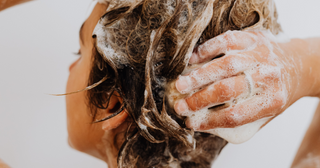When I was younger, I was careless about my hair health, washing it every day with whatever shampoo and conditioner my mum bought.
After turning 21, my interest in hair health extended. I started researching more about scalp health, my hair type, and whether my haircare products are silicone- and sulfate-free. Now, my biggest question is how often should I wash my hair.
Many beauty experts say there is no correct answer to this question. Everyone has a different hair type, body chemistry, and surrounding environment. So, it can depend on your hair type, your lifestyle and your hair’s porosity.
Understanding the hair’s porosity and three layers
Hair’s porosity is its ability to absorb and retain moisture.
- Low porosity: the cuticles are tightly close to each other.
- Medium porosity: the cuticles are less tightly packed.
- High porosity: the cuticles are widely spaced.
Hair’s three layers are…
- The cuticle: this is the protective outer layer of your hair. It’s overwrapping each other.
- The cortex: it’s the thickest layer of your hair. It has fibrous proteins and pigments that give your hair a colour.
- The medulla: this is the central part of your hair.
To keep your hair healthy and nourished, your haircare products must pass through the cuticle to reach the cortex. However, these products can’t pass through if your cuticles are too packed. On the other hand, if your cuticles are too spaced, your hair will not be able to retain moisture and will become dehydrated.
To test your hair porosity, simply use a glass of water.
- Wash your hair to remove sebum, dust and any product build-up.
- Fill a glass of water
- After you dry your hair, drop a single strand into the water.
- If the strand floats on top, it’s low porosity, and if it sinks to the middle, it’s medium porosity. If it sinks straight to the bottom, it’s high porosity.
Low-porosity hair has a hard time absorbing moisture, leading to buildup quickly. Therefore, it needs to be washed more frequently than high-porosity hair.
Each hair type has its conditions
- Thin and oily hair: This hair type can get greasy more quickly as the oil produced by the scalp can weigh down the hair. It is recommended to wash your hair every other day with a shampoo that has an oil-free/ balancing option.
- Thick and dry hair: This hair type can go longer between wash days, such as once or twice a week. Their hair doesn’t get as oily compared to the others. Therefore, washing too frequently can remove its natural oils and make it drier.
- Textured/curly hair: These hair types are mostly drier than straight hair. It’s recommended to wash it only once or twice per week.
Overwashing can damage your hair
We use shampoo to clean the scalp and remove oil. However, overusing it can strip essential oils that moisturise your scalp and hair, leaving them too dry.
As mentioned in the previous article, dehydrated skin produces more oil. The same goes for hair. Washing too often results in dry hair and scalp, and more sebum production.
Takeaways
If you want to improve your hair and scalp health, start by testing your hair’s porosity and type. Choose a silicone-free and sulfate-free shampoo and conditioner. It is also recommended to use glycolic acid toner for weekly scalp exfoliation and hair oiling as a pre-shower treatment for extra nourishment.
